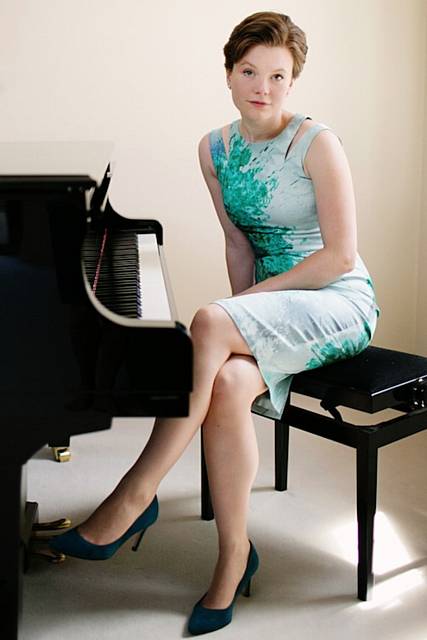Clare Hammond’s Rochdale Music Society Concert
Date published: 16 May 2017

Clare Hammond
Clare Hammond’s return to the Rochdale Music Society’s concert platform in Heywood Civic Centre on 13May 2017 proved even more remarkable than had been her first appearance in the Society’s concert series in 2016, when her dazzling pianism was obvious to all privileged to be present on that occasion.
Once again, she demonstrated her capacity to bring vividly to life the musical visions of composers old and new with an assurance that was as complete in its technical accomplishment as it was in its artistic depth of feeling.
Her recital began with the Suite in G (1707) by a French composer well-known in her generation but sadly neglected since, Elisabeth Jacquet de la Guerre. This set of sic dance movements reveal de la Guerre’s talent for writing attractive keyboard music every bit as intricate, delicate and expressive as that of her better-known contemporaries, such as Couperin and Lully. Clare Hammond’s account of these was flawless in its overall approach and detailed execution of the stylised ornamentation which gives such music its distinctive flavourings.
Whether the next item in her programme is one of a composer whose name will be better known in the future than it is as yet remains to be seen. The British composer, James Francis Brown (born 1969), is one of those of our own time when composers struggle to find their own identity in the aftermath of all the technical experimentation that threatened a return to melodic and harmonic chaos in the twentieth century.
We in the so-called ‘developed’ world live in an age of ‘freedom’ where ‘anything goes’ in pretty well every area of human activity and endeavour. The danger is that things become over-developed and either imprisoned in their own cultural obesity or robbed of any real expression worth communicating. It was refreshing to be able to listen to music like this which, like the Fauré E minor Nocturne that was to be played later, has the stamp of a real personality exploring the outer regions of its self-awareness and being content to do so.
Beethoven’s Sonata No. 4 in E flat Op. 7 filled out the rest of the first half of this concert. It is often referred to as ‘The Grand Sonata’ because of its length and depth of feeling, intense in every movement. Clare brought to her performance the ear of an interpreter steeped in its inner strength of relentless movement, sometime very swift (as in the outer movements), sometimes very slow (as in the second, Largo, movement). It was still the 18th century when this music was written, but it was opening up artistic and technical vistas that would be explored again and again by the Romantics of the 19th century, and remain open to our astonishment in the 21st century. A robust and heartfelt performance leaving the listener with the pleasurable excitement of wanting more!
The second half began with that tour de force of experimental textures, harmonies and other devices which go to make for the intense enjoyment to be found in Debussy’s L’isle joyeuse - the ‘joyful island’ of Watteau’s painting, ‘L’embarquement pour Cythare’. It conjours up the scene of the voluptuous love revels of a party of aristocrats on the island sacred to Venus, goddess of love. Enough said. Clare Hammond entered into those revels with clear vision and pianistic triumph.
Henri Dutilleux’s name is one that has come to be much appreciated by those who have followed the development of French musical composition in the twentieth century. He represents a much more accessible development in musical language than that of the likes of Varèse and Boulez. His six piano pieces ‘Au grédes ondes’ (’At the whim of the waves’ - radio waves) provide delicious insights into his personal success in taming chromatic dissonance in a very French way. Clare’s approach to these was as precise and captivating as had been her delivery of the de la Guerre Suite.
Fauré’s Nocturnes rank among his major works for piano and reflect his development as a composer over along span of time. Clare played two of these, No. 8 in D flat and No. 12 in E minor, with consummate attention to the detail of their underlying quest for a melodic and harmonic consensus to satisfy Fauré’s personal artistic quest for integrity.
Finally, Clare offered the audience a 15 minute display of brilliant pianism that brought gasps of delight and appreciation as it finally came to its climactic ending - Stravinsky’s own 1921 arrangement of his ballet music, Petroushka, as a Suite of three Movements. This was truly a magical musical experience with which left one wondering how it is possible for someone to exercise such individual control over every finger on both hands.
The applause which then greeted Clare prompted her to take to the piano stool again and round off a wonderful evening’s music-making with a serene and mouth-watering account of a Scarlatti Sonata.
Do you have a story for us?
Let us know by emailing news@rochdaleonline.co.uk
All contact will be treated in confidence.
Most Viewed News Stories
- 1Middleton school hails another outstanding inspection result
- 2Former councillor and hospital campaigner Jean Ashworth has died
- 3No trams between Oldham and Rochdale this Sunday
- 4Drugs and cash seized during morning raids at suspected stash houses
- 5Northern Healthcare opens supported living service in former Rochdale hotel
To contact the Rochdale Online news desk, email news@rochdaleonline.co.uk or visit our news submission page.
To get the latest news on your desktop or mobile, follow Rochdale Online on Twitter and Facebook.


